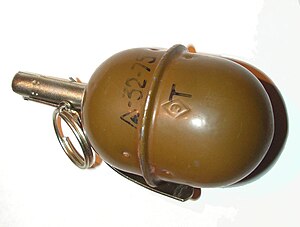RGD-5
| RGD-5 | |
|---|---|

RGD-5 hand grenade with UZRGM fuze fitted
|
|
| Type | Hand grenade |
| Place of origin |
|
| Service history | |
| In service | 1954–present |
| Wars |
Vietnam War Six-Day War Yom Kippur War Soviet War in Afghanistan Iran-Iraq War Invasion of Kuwait First Chechen War Second Chechen War Iraq War 2008 South Ossetia War 2011 Libyan Civil War Syrian Civil War War in Donbass |
| Specifications | |
| Weight | 310 g |
| Length | 117 mm |
| Diameter | 58 mm |
|
|
|
| Effective firing range | 15–20 meters |
| Maximum firing range | 30 meters |
| Filling | Trinitrotoluene |
| Filling weight | 110 g |
|
Detonation
mechanism |
3.2 to 4 seconds. pyrotechnic delay fuse |
The RGD-5 (Ruchnaya Granata Distantsionnaya) English "Hand Grenade Remote", is a post-World War II Soviet anti-personnel fragmentation grenade, designed in the early 1950s. RGD-5 was accepted to service in 1954. It is still in service with many of Russia's former client states and has been supplied to Iraq as well as other Arab nations.
The grenade contains a 110-gram (3.9 oz) charge of TNT with an internal fragmentation liner that produces around 350 fragments and has a lethality radius of 25 metres (82 ft). The weight of the grenade with the fuze fitted is 310 grams (11 oz). Typically, the RGD-5 uses the 3.2 to 4 second delay UZRGM fuze, a universal Russian type which is also used in the RG-41, RG-42, and F1 grenades. The RGD-5 may also be fitted with the more modern DVM-78 fuze, or variants of the UZRGM with delays of between zero (i.e. instantaneous for use in booby traps) and 13 seconds. It is also possible to screw an MUV booby-trap firing device into the fuze well.
The grenade is egg-shaped with no external ribbing, except for a lateral ridge where the two halves of the grenade join. The surface has a few small dimples on it with a green or olive drab, paint-scheme. The RGD-5 can be thrown about 35 to 45 metres (115 to 148 ft) by the average male soldier and when thrown, it is possible to hear a loud "pop" as the fuze ignites and begins to burn. The grenade can inflict injuries (e.g. penetrating eye wounds) out to 15 metres (49 ft) from the site of detonation. Victims caught within 3 metres (10 ft) of the detonation site are almost certain to be killed or severely wounded.
This grenade is still manufactured in Russia with copies produced in Bulgaria, China (as the Type 59) and Georgia. Many millions of RGD-5s and its clones have been manufactured over the years and although not as advanced as more modern grenades which are specifically designed to penetrate CRISAT standard body armour, the RGD-5 is still an effective and inexpensive weapon. A single RGD-5 grenade costs around $5 US, making it highly affordable during a major conflict when many grenades are required.
...
Wikipedia
